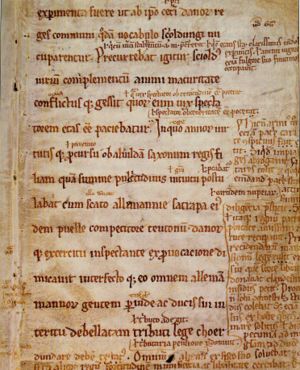
Angers Fragment
Encyclopedia

Parchment
Parchment is a thin material made from calfskin, sheepskin or goatskin, often split. Its most common use was as a material for writing on, for documents, notes, or the pages of a book, codex or manuscript. It is distinct from leather in that parchment is limed but not tanned; therefore, it is very...
pages from c. 1200. It is one of the four fragments remaining of the original Saxo Gesta Danorum
Gesta Danorum
Gesta Danorum is a patriotic work of Danish history, by the 12th century author Saxo Grammaticus . It is the most ambitious literary undertaking of medieval Denmark and is an essential source for the nation's early history...
. This fragment is the only fragment attested to be of Saxo's own handwriting. It consists of four pages with 8 written sides.
History
It is first spoken of in Albert Lemarchand book Catalogue des manuscripts de la Bibliothèque d'Angers, 1863, page 90, in the same library were it had been used as binding for an old book from the 15th century. First identified in 1877, by Gaston ParisGaston Paris
Bruno Paulin Gaston Paris , known as Gaston Paris, was a French writer and scholar.He was nominated for the Nobel Prize in Literature in 1901, 1902 and 1903.-Biography:Paris was born at Avenay...
and in 1878 exchanged to the Danish Royal Library
Danish Royal Library
The Royal Library in Copenhagen is the national library of Denmark and university library of University of Copenhagen. It is the largest library in the Nordic countries....
for the manuscript charter of the abbey of Saint-Martin-des-Champs in Paris
Paris
Paris is the capital and largest city in France, situated on the river Seine, in northern France, at the heart of the Île-de-France region...
. It has the Royal Library signature of Ny kgl. Saml. 4to, 869 g.
Correspond to page 24-29 in Peter Erasmus Müller
Peter Erasmus Müller
Peter Erasmus Müller , was a Danish bishop, historian, linguist and professor of theology.-Biography:He was born at Copenhagen, and studied at the university there, passing his theological examination in 1791. After spending some time in the German universities, he visited France and England...
Latin version of Gesta Danorum from 1839 or page 11.19 – 16.29 in Jørgen Olrik & H. Ræder's Latin version of Gesta Danorum from 1931.

